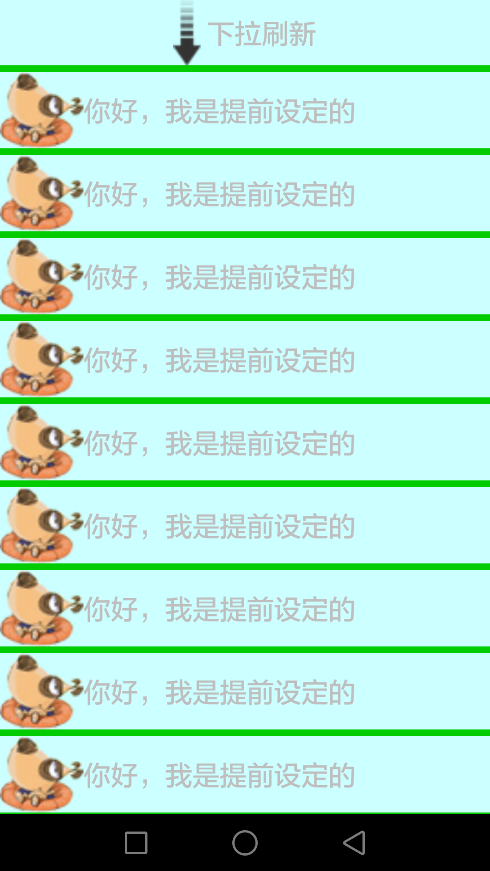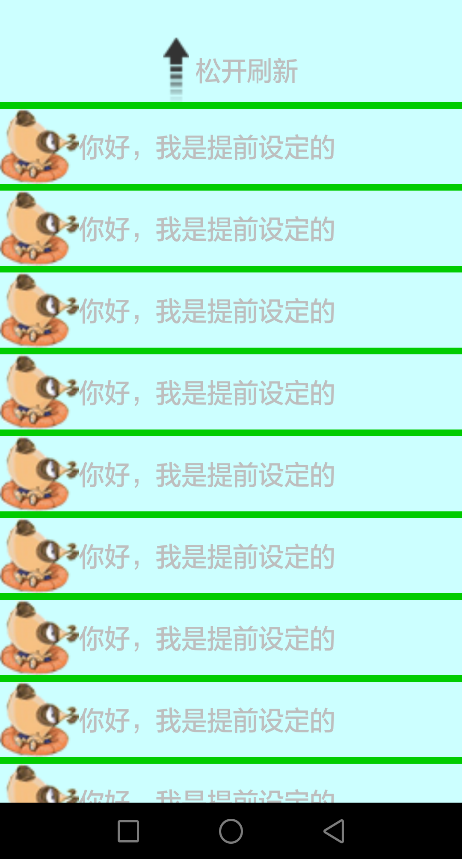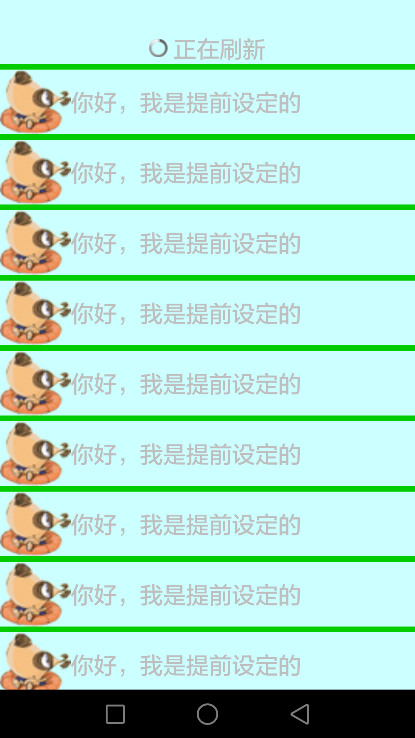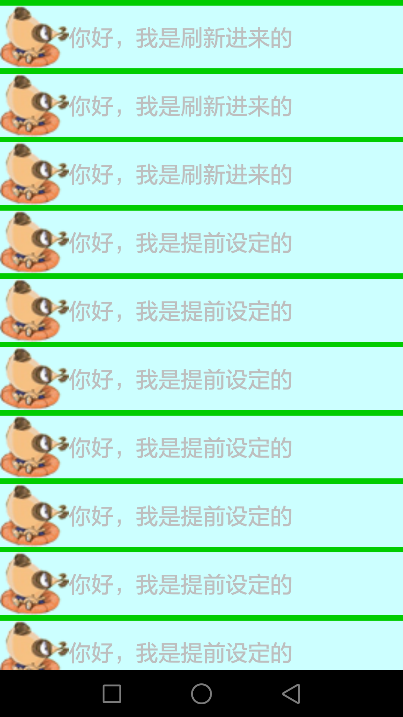ListView实现下拉刷新(一)建立头布局
一、效果演示
ListView实现下拉刷新,是很常见的功能。下面是一个模拟的效果,如下图:




效果说明:当往下拉ListView的时候,顶部就会有一个“下拉刷新”的标识被拉 出来,再往下拉的时候,标识就会变成”松开刷新“,期间还伴随一个箭头的变化。此时松开手指,则会变成进度条提示正在刷新,刷新完成后,则加载进来刷新的数据。如此反复,就是下拉刷新的功能。
二、准备Demo
其实本质上,ListView实现下拉刷新和实现分页加载都是一样的,都是一个自定义的ListView而已。甚至可以说,原理基本相同,只不过下拉刷新头布局变化相对分页加载复杂一点。
因此,我们仍旧使用《listView实现分页加载》里面的Demo,即首先搭建一个正常下的ListView,准备点模拟的数据。可以点击下面的链接,查看Demo的编写:
http://www.cnblogs.com/fuly550871915/p/4866929.html
三、实现头布局
好了,模拟的东西都准备完成了。下面我们首先编写头布局。比较简单,就是一个箭头,进度条好文本而已。命名为header.xml。代码如下:
<?xml version="1.0" encoding="utf-8"?>
<LinearLayout xmlns:android="http://schemas.android.com/apk/res/android"
android:layout_width="match_parent"
android:layout_height="match_parent"
android:orientation="horizontal"
android:gravity="center"> <ProgressBar
android:id="@+id/progress_bar"
android:layout_width="wrap_content"
android:layout_height="wrap_content"
android:visibility="gone"
style="?android:attr/progressBarStyleSmall"/>
<ImageView
android:id="@+id/img_arrow"
android:layout_width="wrap_content"
android:layout_height="wrap_content"
android:src="@drawable/down_arrow"/>
<TextView
android:id="@+id/textinfo"
android:layout_width="wrap_content"
android:layout_height="wrap_content"
android:paddingLeft="5dp"
android:textSize="20dp"
android:text="下拉刷新"/> </LinearLayout>
然后,我们就开始自定义ListView吧。新建类MyListView,继承自ListView。在这里加上头布局即可。代码如下:
package com.fuly.load; import android.content.Context;
import android.util.AttributeSet;
import android.view.LayoutInflater;
import android.view.View;
import android.widget.ListView; public class MyListView extends ListView{ private View header;//头布局 //三个构造方法都要重写
public MyListView(Context context) {
super(context);
initView( context); }
public MyListView(Context context, AttributeSet attrs) {
super(context, attrs);
initView( context); }
public MyListView(Context context, AttributeSet attrs, int defStyle) {
super(context, attrs, defStyle);
initView( context); } public void initView(Context context){ header = LayoutInflater.from(context).inflate(R.layout.header, null); //将头布局加进去
this.addHeaderView(header);
} }
自定义的ListView已经准备好了,下面就替换吧。修改activity_main.xml里的代码即可,如下:
<LinearLayout xmlns:android="http://schemas.android.com/apk/res/android"
xmlns:tools="http://schemas.android.com/tools"
android:layout_width="match_parent"
android:layout_height="match_parent"
android:background="#ccffff"> <com.fuly.load.MyListView
android:id= "@+id/list_view"
android:layout_width="match_parent"
android:layout_height="match_parent"
android:dividerHeight="5dp"
android:divider="#00cc00"></com.fuly.load.MyListView>
</LinearLayout>
至此,我们已经把带头布局的ListView做好了。运行一下程序,会发现就是效果图的第一张。
那么,怎么来隐藏头布局呢?这并不简单,是下一节要详细说的内容。
ListView实现下拉刷新(一)建立头布局的更多相关文章
- Android开发 - 下拉刷新和分段头悬停列表
项目源码 本文所述项目已开源,源码地址 为什么做PullToRefresh-PinnedSection-ListView 前段时间因为项目需求,需要在Android中对ListView同时增加下拉刷新 ...
- ListView实现下拉刷新(三)实现下拉刷新
该准备的东西都已经准备好了.在这篇文章里,我们就开始实现下拉刷新功能吧. 一.大体的逻辑分析 我们来简单分析一下需要做的逻辑吧.首先分析头布局有几种状态.不下拉时,为正常状态,此时头布局隐藏.下拉到一 ...
- Android UI--自定义ListView(实现下拉刷新+加载更多)
Android UI--自定义ListView(实现下拉刷新+加载更多) 关于实现ListView下拉刷新和加载更多的实现,我想网上一搜就一堆.不过我就没发现比较实用的,要不就是实现起来太复杂,要不就 ...
- android--------自定义控件ListView实现下拉刷新和上拉加载
开发项目过程中基本都会用到listView的下拉刷新和上滑加载更多,为了方便重写的ListView来实现下拉刷新,同时添加了上拉自动加载更多的功能. Android下拉刷新可以分为两种情况: 1.获取 ...
- ListView实现下拉刷新(二)隐藏头布局
一.问题分析 在上一篇中,我们将头布局加到了ListView上.但是没有隐藏他.你可能会想,隐藏还不简单,直接给它设置为GONE属性不就可以了吗,在需要的时候再设定为可见.没错,这正是ListView ...
- ListView实现下拉刷新和上拉加载功能
1 public class RefreshListView extends ListView implements OnScrollListener { private View mHeaderVi ...
- 自定义ListView实现下拉刷新,下拉加载的功能
package com.loaderman.myrefreshlistviewdemo; import android.content.Context; import android.util.Att ...
- 【转载】 Android PullToRefresh (ListView GridView 下拉刷新) 使用详解
Android下拉刷新pullToRefreshListViewGridView 转载请标明出处:http://blog.csdn.net/lmj623565791/article/details/3 ...
- Android PullToRefresh (ListView GridView 下拉刷新) 使用详解
转载请标明出处:http://blog.csdn.net/lmj623565791/article/details/38238749,本文出自:[张鸿洋的博客] 群里一哥们今天聊天偶然提到这个git ...
随机推荐
- 用C语言实现Ping程序功能---转
ping命令是用来查看网络上另一个主机系统的网络连接是否正常的一个工具.ping命令的工作原理是:向网络上的另一个主机系统发送ICMP报文,如果指定系统得到了报文,它将把报文一模一样地传回给发送者,这 ...
- [转]Web API Introduction to OData Services using ASP.NET Web API
本文转自:http://mahedee.net/tag/web-api/ What is OData? OData Stands for Open Data Protocol. It is a dat ...
- group by 语句
user E_book go 这样的程序会出错,因为play没有使用sum,所以要分组. group by play 有函数的和没有函数的表一起使用要用 GROUP BY .AVG 求平均值,只能与数 ...
- jQuery源码分析系列 : 整体架构
query这么多年了分析都写烂了,老早以前就拜读过, 不过这几年都是做移动端,一直御用zepto, 最近抽出点时间把jquery又给扫一遍 我也不会照本宣科的翻译源码,结合自己的实际经验一起拜读吧! ...
- window.open在Safari中不能打开的问题
在调移动支付问题的时候遇到过,用window.open打开一个微信支付链接,唤醒移动支付,在IOS下死活唤醒不了,是js代码冲突问题...是click事件IOS下不兼容问题...最后定位到window ...
- csharp:.net 3.5 using System.Runtime.Serialization.Json read json
using System; using System.Collections.Generic; using System.Linq; using System.Web; using System.We ...
- Grunt完整打包一个项目实例
Grunt确实好用,配置好Gruntfile.js之后,一个命令就行云如流水,程序帮你搞定一切,爽歪歪. 我们先看压缩前的目录: 再看打包后的目录: build是打包后的文件夹,main.css是压缩 ...
- 前端学习之路之CSS (二)
Infi-chu: http://www.cnblogs.com/Infi-chu/ id选择器id 选择器可以为标有特定 id 的 HTML 元素指定特定的样式,CSS 中 id 选择器以 &quo ...
- webapi下载文件
[HttpGet] public IHttpActionResult ExportData() { ... var dt = ExcelHelper.ListToDataTable(list); va ...
- <Android 应用 之路> 百度地图API使用(3)
前言 上一篇讲解并实践了百度地图基本显示,地图类型,实时交通图,热力图,地图控制和手势控制,今天看下在地图上添加view和覆盖物. 地图Logo不允许遮挡,可通过mBaiduMap.setPaddin ...
